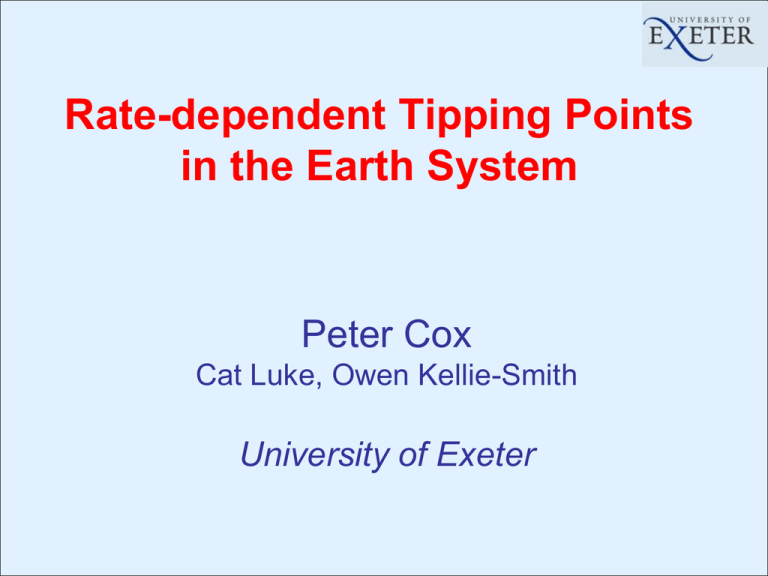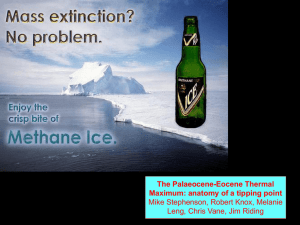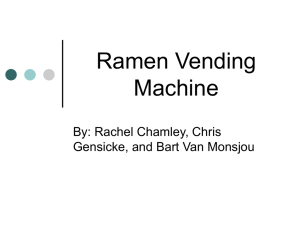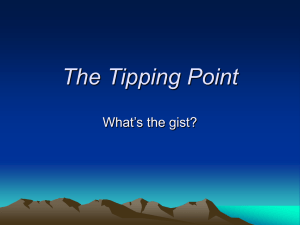Rate-dependent Tipping Points in the Earth System
advertisement

Rate-dependent Tipping Points in the Earth System Peter Cox Cat Luke, Owen Kellie-Smith University of Exeter United Nations Framework Convention on Climate Change (UNFCCC) “The ultimate objective [is]…. stabilization of greenhouse gas concentrations in the atmosphere at a level that would prevent dangerous anthropogenic interference with the climate system…” Introduces the notion of “Dangerous” Climate Change… ….but how can this be defined ? Definitions of Tipping Point “The tipping point is the ….critical point ..at which the future state of the system…can be switched into a qualitatively different state by small perturbations” (based on Lenton et al., 2008) “when the climate system is forced to cross some threshold, triggering a transition to a new state at a rate determined by the climate system itself and faster than the cause” (Abrupt Climate Change, NAS, 2002) Tipping Points and Multiple Equilibria Climate Control Variable (e.g. CO2 Concentration) Climate State Variable (e.g. Temperature, Ice-mass) Tipping Points and Multiple Equilibria Climate Control Variable (e.g. CO2 Concentration) Stable Climate: Climate Change proportional to forcing and reversible Climate State Variable (e.g. Temperature, Ice-mass) Tipping Points and Multiple Equilibria TIPPING POINT Climate Control Variable (e.g. CO2 Concentration) Unstable Equilibrium Climate State Variable (e.g. Temperature, Ice-mass) Tipping Points and Multiple Equilibria Climate Control Variable (e.g. CO2 Concentration) Abrupt Climate Change: System moves spontaneously to a new state independent of forcing Climate State Variable (e.g. Temperature, Ice-mass) Characteristics of Systems with “Classical” Tipping Points Have more than one equilibrium state. “Current” equilibrium becomes unstable at the Tipping Point (gain >1) Magnitude and rate of change at the Tipping Point is a system feature and is independent of the forcing. Crossing a Tipping Point may result in a new stable state, implying a degree of irreversibility or hysteresis. Many possible climate Tipping Points have now been identified. Tipping Points (Lenton et al., 2008) Map of potential policy-relevant tipping elements in the climate system, updated from ref. 5 and overlain on global population density Lenton T. M. et.al. PNAS 2008;105:1786-1793 ©2008 by National Academy of Sciences Characteristics of Systems with “Classical” Tipping Points Have more than one equilibrium state. “Current” equilibrium becomes unstable at the Tipping Point (gain >1) Magnitude and rate of change at the Tipping Point is a system feature and is independent of the forcing. Crossing a Tipping Point may result in a new stable state, implying a degree of irreversibility or hysteresis. Many possible climate Tipping Points have now been identified. In some cases these have been used to estimate dangerous global warming or dangerous levels of CO2…. It may make more sense to think about Dangerous Rates of Change, because: The impacts of climate change depend on the ability of natural and human system to adapt, and this depends fundamentally on how fast the change occurs. Although the long-term “equilibrium” climate change is uncertain, rates of climate change are more strongly constrained by contemporary observations. Focusing on rates of change may allow a more adaptive climate mitigation policy. There are potential Tipping Points which are related more to the rate of change that its ultimate magnitude in the longterm…. Rate-dependent Tipping Points Slow –ve feedback SLOW VARIABLE FLUX Fast +ve feedback + FAST VARIABLE Forcing of Fast Loop Tipping point can occur if forcing is “faster” than the slow negative feedback loop Tipping Points (Lenton et al., 2008) Map of potential policy-relevant tipping elements in the climate system, updated from ref. 5 and overlain on global population density Lenton T. M. et.al. PNAS 2008;105:1786-1793 ©2008 by National Academy of Sciences Stability of Peatlands Peatland soils are estimated to contain 400-1000 GtC Peatland carbon and hydrology are tightly coupled, giving the possibility of two-equilibrium states and tipping points. Could Peatland soils may also be destabilized by Biochemical Heat Release from decomposition ? Compost-Bomb Instability Depletion of Soil Carbon Biochemical Heat Release SOIL RESPIRATION Slow –ve feedback - Fast +ve feedback + SOIL CARBON SOIL TEMPERATURE Global Warming See Poster by Catherine Luke..... Numerical Solutions for Constant Rate of Global Warming Cs (0) = 50 kg C m-2, W m-2 K-1 Rsref = 0.5 kg C m-2 yr-1, q10 = 2.5 Ts Response 10K 8K Ta forcing 6K Time (yrs) Time (yrs) Luke and Cox, in press Numerical Solutions for Dangerous Rate of Global Warming Dangerous Rate of Warming Cs (0) = 50 kg C m-2, W m-2 K-1 Rsref = 0.5 kg C m-2 yr-1, q10 = 2.5 Luke and Cox, in press Stability of the Climate-Economy System Economies have a tendency to grow….. Economic growth has been correlated with global CO2 emissions. Global CO2 emissions lead to climate change. Climate change impacts imply damages to the economy. How might this climate impact on the economy affect the dynamics of the coupled Climate-Economy system ? Climate-Economy Coupling Carbon Intensity of Economy Slow –ve feedback Economic Growth Climate Damages CO2 Emissions Investment GLOBAL WEALTH How fast can the global economy grow and still have a ‘soft landing’ for the climate-economy system ? Simple Climate-Economy Model Background CO2 Emissions Growth-rate of 1% and 4% Without climate impacts on economy Economic Depression due to Environmental change Dynamical Regimes in the Simple Climate-Economy Model Conclusions Many potential climate Tipping Points have been identified. There have been attempts to use these Tipping Points to define dangerous levels of global warming or CO2 concentrations. The ability of human and natural systems to adapt depends much more on the rate at which climate changes. We have identified two very different examples of ratedependent instabilities in the Earth system. These may represent a generic class of rate-dependent Tipping Points. Climate Change Projection IMPACTS IPCC WG2 CLIMATE CHANGE CLIMATE IMPACTS ON THE ECONOMY IPCC WG1 GHG EMISSIONS IPCC WG3 SOCIOECONOMICS Impact of Biochemical Heat Release Response to a Step Perturbation in T Without decomposition heating With decomposition heating “Decomposition ‘self-heating’ is an essential process to account for, capable of fostering a self-sustainable mobilization of soil carbon…” Khvorostyanov et al., 2008 Simple Model of Impact of Soil Biochemical Heat Release The stability of the soil is determined by the “Zimov Number” : This represents the increase in biochemical heating per unit warming divided by the increase in heat loss per unit warming. Soils are potentially unstable if : Stability Diagram for Peat Soils Rsref = 0.5 kg C m-2 yr-1, q10 = 2.5 UNSTABLE Warming STABLE Drying Luke and Cox, in prep. …not a sufficient condition for instability- also depends on rate of warming







